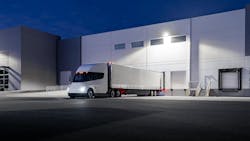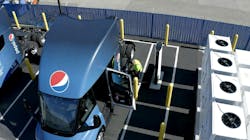Since Elon Musk first showed off a prototype in 2017, Tesla has been promising its Class 8 electric truck would change freight transportation in the U.S. Despite only delivering dozens of trucks to fleet customers over the past seven years, the EV automaker is still making promises about the Tesla Semi’s future dominance in trucking while the rest of the industry continues to focus on the real world.
Dan Priestley, Tesla’s senior manager of Semi truck engineering, said last week that the automaker plans to not just exist in the world of heavy-duty trucking but to dominate it.
“When we talk scale, we're talking big scale,” Priestley noted in front of a packed audience on the 2024 Advanced Clean Transportation Expo’s main stage at the Las Vegas Convention Center’s West Hall. He said the automaker’s Nevada Gigafactory would start serial production of the Class 8 battery-electric truck in 2026, with “an eventual target capacity of 50,000 units a year.”
This may invite skepticism in those following the Semi’s path to commercialization, as it would be a full decade from being announced (in 2016) to serial production. CEO Elon Musk unveiled a prototype in 2017, with production promised for 2019. The industry is still waiting on serial production as legacy OEMs are already delivering hundreds of Class 8 EVs to West Coast and East Coast fleets.
See also: It really is messy in the middle
Tesla doubters continue to hear hype as deliveries delay
Priestley acknowledged the doubters with an opening quip that Tesla’s specialty is “turning the impossible into merely late.” That got more than a few chuckles from the thousands of trucking stakeholders in the ACT Expo audience.
As the Semi’s production dates keep shifting, many in the transportation industry have also made plenty of jokes about Tesla’s much-hyped heavy-duty EV. Many wrote the truck off as another unrealistic musing that Musk got bored with, like his Boring Company’s Hyperloop project.
Tesla hopes that its latest plans, paired with real-world data from test fleet PepsiCo (No. 2 on the FleetOwner 500: Private) and third-party testing from the non-profit North American Council for Freight Efficiency, will reignite the excitement of seven years ago.
For starters, the Tesla Semi is closer to parity with diesel trucks than other electric offerings. A recent Ryder Systems study based on current EVs in their fleet suggested it would take two heavy-duty EVs to perform the same work as one diesel, due to weight restrictions—EV batteries make them much heavier— and the time difference between refueling a diesel and recharging an electric truck.
“We understand that maximizing payload is key for customer success,” Priestley said. “Achieving strong range-to-mass ratios is only possible with a dedicated, purpose-built, ground-up electric platform—exactly what the Tesla is.
“There is no wasted space. The powertrain and the vehicle work hand in hand," he added but declined to share how much the Semi’s batteries weigh and how much cargo capacity it leaves for freight.
With 3.5 million miles of Semi data, Priestley claims the fleets using the Semi “can swap one for one in operations,” citing NACFE’s Run on Less—Electric Depot event last fall, where a PepsiCo-operated Tesla Semi was recorded as traveling 410 miles on one charge, and 1,076 miles over a full day.
See also: How is clean vehicle technology adoption doing among fleets?
“Fast charging enables that,” Priestley said. “More than 60% of those miles were above 70,000-lb. gross combination weight.”
According to the Tesla exec, Pepsi’s Fresno depot, which is expected to receive an additional 50 Tesla Semis, also has a Tesla Megacharger. The plug is more robust than a typical EV charger, and Tesla says the Semi can “recover 70% of range in 30 minutes” using it. According to Bloomberg, Tesla plans to build a network of nine Megachargers between California and Texas.
“Megawatt-level fast charging is available, reliable, safe, and unlocks the next level of economics,” Priestley noted. “What this does is it unlocks operational equivalence between diesel and electric."
The other key was opportunity charging. As it takes the same amount of time to charge an EV battery from 20% to 80% as it does 80% to 100%, they didn’t spend time on “topping off” and focused on the most efficient charging cycle.
“Electric is efficient,” Priestley promised. “It allows you to move more goods with less energy, plain and simple, and we want to take that and use heavy or fast charging and take that difference in cost with a greater efficiency and push as many miles and tons through that to give you the absolute fastest economic payback possible.”
Tesla continues to promise reliability of Semi that few have used
The big question was never really whether Tesla could engineer a machine to push the upper limits of efficiency. It was always whether they could make a lot of them that could consistently stand up to the rigors of trucking and be available when needed.
Priestley noted that many powertrain hardware and software efforts have been made to “ensure the vehicle is not just capable but also predictable and reliable.”
For example, the high-efficiency heat pump system “gives us huge amounts of confidence and reliability.”
Priestly noted the Semi has shown “uptime greater than 95%—this includes both preventative and unscheduled maintenance.”
Apparently, this is across a diverse range of temperatures and topography. Priestley explained that Tesla uses Semis to haul batteries from their Nevada Gigafactory in Sparks to the plant in Fremont, California, a 260-mile trip that stretches over mountains, with variations in climate and weather, on highways, and in cities.
See also: A high-def history reminder as we focus on the future
Through it all, the Semi also averages 1.7 kWh per mile, he said.
At a later discussion, Priestley noted the Semi had been tested at negative-35 degrees F in Alaska and 120 degrees F in Death Valley.
“We really like to push the vehicle to its absolute limit,” Priestley said. “And it sweated, but it did really well.”
A key to the uptime is Tesla’s select group of service technicians and tools developed in-house, along with leveraging the company’s vertical integration and supply network, as well as vast amounts of experience in maintaining and servicing nearly 5 million light-duty EVs for over 15 years.
“We do our own training, and we developed physical as well as virtual information to allow the technicians to do their job effectively and ultimately get the product back into the world earning money as quickly as possible,” Priestley said.
Later on the stage, Priestley offered that, unlike many car dealers, Telsa does not target service as a major profit center for the company.
He said that light-duty dealers try to extract profit from lifetime vehicle service deals on the equipment they sell. But Tesla's focus, which does not include a traditional dealer network, is "not looking to do everything ourselves on the heavy-duty side,” he said.
Instead, fleets and third-party providers can share the maintenance load. This is already being done at Pepsi, and Priestly noted any shop can do wheels and tires. For proprietary technology, Priestley suggested Tesla could even send mobile maintenance trucks out.
“But if your fleet or your business has a service division that you want to empower and enable, we can figure out what that balance is between what you do versus what Tesla does, so we can scale it effectively and provide you with the right tools, physical or virtual, so you can take out those jobs and do so reliably and successfully,” Priestly told fleets.
Infrastructure and beyond
Ultimately, Tesla intends for the Semi to be a general tool, with potential uses including car hauling and refrigerated transport, as the tractor battery can also power the trailer. Truckload, LTL, and drayage are other duty cycles.
The next step is building out a larger charging network.
“This year, we are investing more than $500 million in new supercharger stations, expanding the network,” Priestley said. The Megachargers will not just be “behind the fence” at private locations such as the Gigafactory and Pepsi, but eventually, at public areas, Priestley likened to retail truck stops.
"We've deployed more than 50,000 DC fast chargers worldwide today, and we have really refined the way that we can do this quickly as well as cheaply,” stated Priestley, explaining this was done by driving cost down with prefabricated units, streamlined engineering and construction.
While the current cost for heavy-duty charging is $1,000/kW, if and when Telsa achieves economies of scale, they can slash that to $500/kW.
This article was originally posted on Fleet Maintenance.
About the Author
John Hitch
Editor
John Hitch is the editor-in-chief of Fleet Maintenance, providing maintenance management and technicians with the the latest information on the tools and strategies to keep their fleets' commercial vehicles moving. He is based out of Cleveland, Ohio, and was previously senior editor for FleetOwner. He previously wrote about manufacturing and advanced technology for IndustryWeek and New Equipment Digest.



